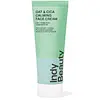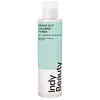What's inside
What's inside
 Key Ingredients
Key Ingredients

 Benefits
Benefits

 Concerns
Concerns

 Ingredients Side-by-side
Ingredients Side-by-side

Water
Skin ConditioningGlycerin
HumectantPolyglyceryl-3 Dicitrate/Stearate
EmulsifyingCoco-Caprylate/Caprate
EmollientSqualane
EmollientCaprylic/Capric Triglyceride
MaskingAvena Sativa Kernel Oil
Skin ConditioningCetyl Alcohol
EmollientC10-18 Triglycerides
EmollientButyrospermum Parkii Butter
Skin ConditioningCentella Asiatica Leaf Extract
Skin ConditioningSqualene
EmollientCeramide NP
Skin ConditioningCeramide AP
Skin ConditioningCeramide EOP
Skin ConditioningAvena Sativa Kernel Flour
AbrasiveSodium Hyaluronate
HumectantTocopheryl Acetate
AntioxidantSorbitan Isostearate
EmulsifyingPanthenol
Skin ConditioningPantolactone
HumectantBeta-Glucan
Skin ConditioningAllantoin
Skin ConditioningXanthan Gum
EmulsifyingPolysorbate 60
EmulsifyingPhytosphingosine
Skin ConditioningTocopherol
AntioxidantHippophae Rhamnoides Fruit Extract
Skin ConditioningGlycine Soja Oil
EmollientBeta-Sitosterol
Emulsion StabilisingHydroxyethyl Acrylate/Sodium Acryloyldimethyl Taurate Copolymer
Emulsion StabilisingEthylhexylglycerin
Skin ConditioningCitric Acid
BufferingRosmarinus Officinalis Leaf Extract
AntimicrobialCarbomer
Emulsion StabilisingMaltodextrin
AbsorbentSodium Benzoate
MaskingPotassium Sorbate
PreservativeCholesterol
EmollientLevulinic Acid
PerfumingSodium Levulinate
Skin ConditioningSodium Lauroyl Lactylate
EmulsifyingPhenoxyethanol
PreservativeLactic Acid
BufferingCI 75810
Cosmetic ColorantWater, Glycerin, Polyglyceryl-3 Dicitrate/Stearate, Coco-Caprylate/Caprate, Squalane, Caprylic/Capric Triglyceride, Avena Sativa Kernel Oil, Cetyl Alcohol, C10-18 Triglycerides, Butyrospermum Parkii Butter, Centella Asiatica Leaf Extract, Squalene, Ceramide NP, Ceramide AP, Ceramide EOP, Avena Sativa Kernel Flour, Sodium Hyaluronate, Tocopheryl Acetate, Sorbitan Isostearate, Panthenol, Pantolactone, Beta-Glucan, Allantoin, Xanthan Gum, Polysorbate 60, Phytosphingosine, Tocopherol, Hippophae Rhamnoides Fruit Extract, Glycine Soja Oil, Beta-Sitosterol, Hydroxyethyl Acrylate/Sodium Acryloyldimethyl Taurate Copolymer, Ethylhexylglycerin, Citric Acid, Rosmarinus Officinalis Leaf Extract, Carbomer, Maltodextrin, Sodium Benzoate, Potassium Sorbate, Cholesterol, Levulinic Acid, Sodium Levulinate, Sodium Lauroyl Lactylate, Phenoxyethanol, Lactic Acid, CI 75810
Water
Skin ConditioningGlycerin
HumectantC15-19 Alkane
SolventCaprylic/Capric Triglyceride
MaskingButylene Glycol
HumectantPanthenol
Skin ConditioningXanthan Gum
EmulsifyingEthylhexylglycerin
Skin ConditioningSodium Hyaluronate
HumectantBiosaccharide Gum-1
HumectantPhenoxyethanol
PreservativeCitric Acid
BufferingAvena Sativa Kernel Oil
Skin ConditioningCannabis Sativa Seed Oil
EmollientCetearyl Alcohol
EmollientGlyceryl Stearate Se
EmulsifyingPolyacrylate Crosspolymer-6
Emulsion StabilisingAllantoin
Skin ConditioningT-Butyl Alcohol
PerfumingPantolactone
HumectantCI 75810
Cosmetic ColorantWater, Glycerin, C15-19 Alkane, Caprylic/Capric Triglyceride, Butylene Glycol, Panthenol, Xanthan Gum, Ethylhexylglycerin, Sodium Hyaluronate, Biosaccharide Gum-1, Phenoxyethanol, Citric Acid, Avena Sativa Kernel Oil, Cannabis Sativa Seed Oil, Cetearyl Alcohol, Glyceryl Stearate Se, Polyacrylate Crosspolymer-6, Allantoin, T-Butyl Alcohol, Pantolactone, CI 75810
 Reviews
Reviews

Ingredients Explained
These ingredients are found in both products.
Ingredients higher up in an ingredient list are typically present in a larger amount.
Allantoin is a soothing ingredient known for its protective and moisturizingg properties. Because of this, it is often added to products with strong active ingredients.
Studies show higher concentrations of this ingredient can promote wound healing.
Though it can be derived from the comfrey plant, allantoin is produced synthetically for cosmetic products to ensure purity.
Learn more about AllantoinAvena Sativa Kernel Oil is the oil from colloidal oatmeal.
Besides being a healthy breakfast, oats have many benefits in skincare too.
Colloidal Oatmeal helps sooth, hydrate, and protect the skin. The starches in colloidal oatmeal are able to bind water, keeping the skin hydrated.
Avena Sativa Kernel Oil is also an antioxidant. Antioxidants help stabilize free-radical molecules. These molecules may damage skin cells.
Overall,Avena Sativa Kernel Oil is great at providing the skin with moisture. It also protects the skin as an antioxidant.
Learn more about Avena Sativa Kernel OilThis ingredient is an emollient, solvent, and texture enhancer. It is considered a skin-softener by helping the skin prevent moisture loss.
It helps thicken a product's formula and makes it easier to spread by dissolving clumping compounds.
Caprylic Triglyceride is made by combining glycerin with coconut oil, forming a clear liquid.
While there is an assumption Caprylic Triglyceride can clog pores due to it being derived from coconut oil, there is no research supporting this.
Learn more about Caprylic/Capric TriglycerideCi 75810, or Chlorophyll, is a coloring and masking ingredient from green plants.
It is used to give products a green color.
Citric Acid is an alpha hydroxy acid (AHA) naturally found in citrus fruits like oranges, lemons, and limes.
Like other AHAs, citric acid can exfoliate skin by breaking down the bonds that hold dead skin cells together. This helps reveal smoother and brighter skin underneath.
However, this exfoliating effect only happens at high concentrations (20%) which can be hard to find in cosmetic products.
Due to this, citric acid is usually included in small amounts as a pH adjuster. This helps keep products slightly more acidic and compatible with skin's natural pH.
In skincare formulas, citric acid can:
While it can provide some skin benefits, research shows lactic acid and glycolic acid are generally more effective and less irritating exfoliants.
Most citric acid used in skincare today is made by fermenting sugars (usually from molasses). This synthetic version is identical to the natural citrus form but easier to stabilize and use in formulations.
Read more about some other popular AHA's here:
Learn more about Citric AcidEthylhexylglycerin (we can't pronounce this either) is commonly used as a preservative and skin softener. It is derived from glyceryl.
You might see Ethylhexylglycerin often paired with other preservatives such as phenoxyethanol. Ethylhexylglycerin has been found to increase the effectiveness of these other preservatives.
Glycerin is already naturally found in your skin. It helps moisturize and protect your skin.
A study from 2016 found glycerin to be more effective as a humectant than AHAs and hyaluronic acid.
As a humectant, it helps the skin stay hydrated by pulling moisture to your skin. The low molecular weight of glycerin allows it to pull moisture into the deeper layers of your skin.
Hydrated skin improves your skin barrier; Your skin barrier helps protect against irritants and bacteria.
Glycerin has also been found to have antimicrobial and antiviral properties. Due to these properties, glycerin is often used in wound and burn treatments.
In cosmetics, glycerin is usually derived from plants such as soybean or palm. However, it can also be sourced from animals, such as tallow or animal fat.
This ingredient is organic, colorless, odorless, and non-toxic.
Glycerin is the name for this ingredient in American English. British English uses Glycerol/Glycerine.
Learn more about GlycerinPanthenol is a common ingredient that helps hydrate and soothe the skin. It is found naturally in our skin and hair.
There are two forms of panthenol: D and L.
D-panthenol is also known as dexpanthenol. Most cosmetics use dexpanthenol or a mixture of D and L-panthenol.
Panthenol is famous due to its ability to go deeper into the skin's layers. Using this ingredient has numerous pros (and no cons):
Like hyaluronic acid, panthenol is a humectant. Humectants are able to bind and hold large amounts of water to keep skin hydrated.
This ingredient works well for wound healing. It works by increasing tissue in the wound and helps close open wounds.
Once oxidized, panthenol converts to pantothenic acid. Panthothenic acid is found in all living cells.
This ingredient is also referred to as pro-vitamin B5.
Learn more about PanthenolPantolactone is a synthetically created humectant.
As a humectant, Pantolactone helps draw moisture to the skin. It can help add hydration to your skin.
Phenoxyethanol is a preservative that has germicide, antimicrobial, and aromatic properties. Studies show that phenoxyethanol can prevent microbial growth. By itself, it has a scent that is similar to that of a rose.
It's often used in formulations along with Caprylyl Glycol to preserve the shelf life of products.
Sodium Hyaluronate is hyaluronic acid's salt form. It is commonly derived from the sodium salt of hyaluronic acid.
Like hyaluronic acid, it is great at holding water and acts as a humectant. This makes it a great skin hydrating ingredient.
Sodium Hyaluronate is naturally occurring in our bodies and is mostly found in eye fluid and joints.
These are some other common types of Hyaluronic Acid:
Learn more about Sodium HyaluronateWater. It's the most common cosmetic ingredient of all. You'll usually see it at the top of ingredient lists, meaning that it makes up the largest part of the product.
So why is it so popular? Water most often acts as a solvent - this means that it helps dissolve other ingredients into the formulation.
You'll also recognize water as that liquid we all need to stay alive. If you see this, drink a glass of water. Stay hydrated!
Learn more about WaterXanthan gum is used as a stabilizer and thickener within cosmetic products. It helps give products a sticky, thick feeling - preventing them from being too runny.
On the technical side of things, xanthan gum is a polysaccharide - a combination consisting of multiple sugar molecules bonded together.
Xanthan gum is a pretty common and great ingredient. It is a natural, non-toxic, non-irritating ingredient that is also commonly used in food products.
Learn more about Xanthan Gum